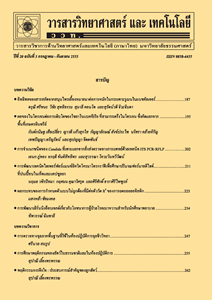การเปรียบเทียบตัวแบบการพยากรณ์จำนวนผู้ป่วยโรคปอดอักเสบในประเทศไทย
Main Article Content
บทคัดย่อ
การวิจัยนี้มีวัตถุประสงค์เพื่อเปรียบเทียบเทคนิคการพยากรณ์เพื่อหาตัวแบบที่เหมาะสมสำหรับพยากรณ์จำนวนผู้ป่วยโรคปอดอักเสบในประเทศไทย ซึ่งเป็นข้อมูลอนุกรมเวลาที่มีแนวโน้มและฤดูกาลที่ชัดเจน เทคนิคการพยากรณ์ที่ใช้ในการศึกษา 3 วิธี คือ วิธีการแยกส่วนประกอบ วิธีปรับให้เรียบแบบเอ็กซ์โปเนนเชียลของวินเตอร์เชิงผลคูณ และวิธีบอกซ์และเจนกินส์ โดยใช้ข้อมูลผู้ป่วยโรคปอดอักเสบในประเทศไทยรายไตรมาส ตั้งแต่ พ.ศ. 2551 ถึง พ.ศ. 2561 เปรียบเทียบตัวแบบพยากรณ์ที่เหมาะสมภายใต้เกณฑ์ค่าร้อยละความคลาดเคลื่อนสัมบูรณ์เฉลี่ย (mean absolute percentage error, MAPE) ต่ำที่สุด ผลการศึกษาพบว่าวิธีบอกซ์-เจนกินส์ให้ค่า MAPE ต่ำที่สุด ตัวแบบที่เหมาะสมในการพยากรณ์จำนวนผู้ป่วยโรคปอดอักเสบ คือ ตัวแบบรวมการถดถอยในตัวกับการเฉลี่ยเคลื่อนที่แบบมีฤดูกาล
Article Details
เอกสารอ้างอิง
Bureau of Epidemiology, Pnuemonia, Retrieved, Available Source: http://www.boe.moph.go.th/boedb/surdata/disease.php?dcontent=def&ds=31, September 8, 2018. (in Thai)
Bureau of Epidemiology, 2019, Pneumonia Situation, Department of Disease Control, Nonthaburi. (in Thai)
WESR, 2019, Disease situation and fatality from pneumonia in Chaiyaphum province, 2014-2018, Weekly Epidemiol. Surveil. Rep. 50(10): 149-156. (in Thai)
Bureau of Epidemiology, 2019, National Disease Surveillance, Department of Disease Control of Thailand, Nonthaburi. (in Thai)
Manmin, M., 2006, Time Series and Fore casting, Prakaypruek Publishing Center, Bangkok. (in Thai)
Keerativibool, W., 2016, Forecasting model for the number of patients with pneumonia in Thailand, Public Health J. Burapha Univ. 11(1): 24-38. (in Thai)
Sanguanrungsirikul, D., Chiewananta vanich, H. and Sangkasem, M., 2015, A comparative study to determine optimal models for forecasting the number of patients having epidemiological-surveillance diseases in Bangkok, KMUTT Res. Develop. J. 38(1): 35-55. (in Thai)
Nakunthod, I. and Khamkhod, K., 2018, Time series modeling for the pneumonia rate of patients in Lampang province, pp. 340-358, Proceeding in 18th Graduate Studies of Northern Rajabhat University Network Conference and 4th Lampang Research, Lampang Rajabhat University, Lampang. (in Thai)
Ruchiraset, A. and Tantrakarnapa, K., 2018, Time series modeling of pneumonia admissions and its association with air pollution and climate variables in Chiang Mai province, Thailand, Environ. Sci. Pollut. Res. 25: 33277-33285.
Bowerman, B.L., O’Connell, R.T. and Koehler, A.B., 2005, Forecasting, Time Series, and Regression: An Applied Approach, Thomson Brooks/Cole, Belmont.
Social and Quality of Life Database System, Number of Cases and Morbidity Rates of Disease Surveillance, Available Source: http://social.nesdb.go.th/social/ Default.aspx?tabid=40, September 8, 2018.
Shumway, R.H. and Stoffer, D.S., 2006, Time Series Analysis and Its Applications: With R Examples, Springer, New York.
R Core Team, 2018, R: A Language and Environment for Statistical Computing, R Foundation for Statistical Computing, Vienna.
Marie, G.C., 2007, Use of ARIMA models for communicable disease surveillance, Revista Cubana de Salud Publica. 33(2).
Unkel, S., Farrington, C.P., Garthwaite, P.H., Robertson, C. and Andrews, N., 2012, Statistical methods for the prospective detection of infectious disease outbreaks: A review, J. R. Stat. Soc. Ser. A 175: 49-82.
Zhang, X., Zhang, T., Young, A.A. and Li, X., 2014, Applications and comparisons of four time series models in epidemiological surveillance data, PLoS ONE 9(2): e88075.


